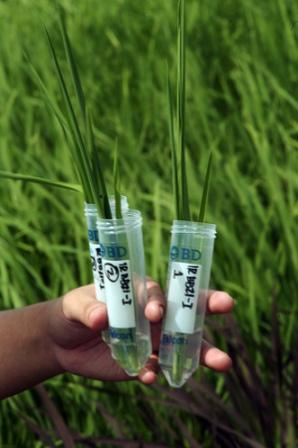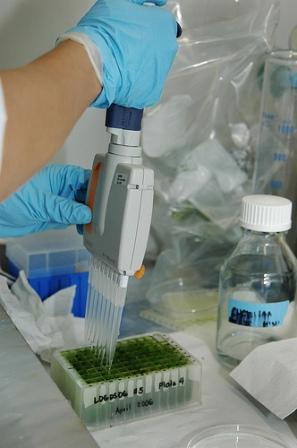DNA bank for cultivated rice, wild rice and related genera genetic resources
Contributors to this page: T.T. Chang Genetic Resources Centre-IRRI, Los Baños, Philippines (Ruaraidh Sackville Hamilton, Ken McNally, Flora de Guzman, Renato Reaño, Soccie Almazan, Adelaida Alcantara, Elizabeth Naredo); WARDA, Cotonou, Benin (Ines Sánchez); UPLB-University of the Philippines at Los Baños (Teresita Borromeo).
|
Contents: |
When DNA banks are used
DNA banks should be used for small core collections of accessions with the intention of repeated use for gene discovery. DNA conservation of rice germplasm is a short-term and expensive alternative. Due to difficulties of molecular characterization of heterogeneous populations, conserving materials as DNA is justifiable only for accessions with immediate value for intensive research.
The DNA bank serves as a cost-effective source for research on identical DNA samples. It does not replace conservation of the original accession as seed.
 Taking rice leaf samples of transgenic lines that will be subjected to DNA extraction in the laboratory (photo: IRRI) |
Source of material (DNA acquisition)
Type of plant material
- Take leaf samples preferably from young healthy leaves (the maximum amount of good quality DNA is obtained from young leaf tissue grown in optimal conditions).
- Continue to grow the sampled plant(s) to maturity and harvest and conserve the seed (harvested seed will constitute the genetic stock that provides the exact match to the DNA).
- Maintain a sample as lyophilized leaf tissue samples and/or extracted DNA (to be conserved as lyophilized leaf samples while awaiting DNA extraction or as a backup for repeat extractions in case of difficulties).
- Apply strict quality control for quantification and verification of use in Polymerase Chain Reaction (PCR).
Amount of plant material
- 2-5 g from individual plants.
Pre-treatments
- None.
Sample preparation
DNA extraction and purification
- According to modified CTAB (Fulton et al., 1995).
DNA replication/multiplication
- DNA samples should be obtained from individual plants (sampling from individual plants is necessary for population structure studies. Depending on the purpose, judicious bulking of plants may be desirable, improving throughput at the expense of reducing information content).
- Use of bulks for accessions that are heterogeneous may lead to difficulty depending on purpose.
Sample packaging
- Store purified samples in 1.5 to 2.0 ml micro centrifuge tubes (storage in plates can lead to cross-contamination).
Recording information during sample processing
The following information must be recorded for each processing step:
- Accession ID (an ID number).
- Seed crop year (year and season of production of the parental seed used to grow the plants from which DNA was extracted).
- Date (date of DNA extraction).
Viability and routine monitoring
 An agricultural research technician performs a Polymerase Chain Reaction (PCR) procedure to determine the presence of alleles or genes with known function or importance (photo: IRRI) |
Storage DNA quality monitoring
Type of test
- Random check using tested PCR markers (verifies that stored samples are usable for molecular analysis).
Number of replicates
- Three.
Frequency
- Annual.
Minimum number of samples
- 96.
Recording information during DNA storage monitoring
The following information must be recorded for each step:
- Accession ID (an ID number).
- Seed crop year (year and season of production of the parental seed used to grow the plants from which DNA was extracted).
- Date (date of DNA extraction).
- DNA concentration.
- DNA concentration date (date on which DNA concentration was measured).
- Comments (DNA quality – visual inspection from agarose gel eletrophoresis).
Storage specifications
Storage conditions
- Store at -20°C for active use (DNA stored at -20°C is usable for at least 2-3 years).
- Store at -80°C for long-term (DNA stored at -80°C is expected to have longevity increased to ten or more years).
Duration of storage
- Depends on results obtained from DNA quality monitoring (despite optimum conditions for storage DNA samples can get degraded through time because of unavoidable freeze-thaw cycles).
Legal arrangements
- Intellectual Property issues may arise associated with the extraction and analysis of DNA: these should be recorded if they affect usage.
- DNA exchange should, like seed exchange, be done under a Material Transfer Agreement (MTA). This will usually be the SMTA if the source germplasm is also distributed under the SMTA (see examples in six languages).
Safety duplication
Since DNA conservation is justified only as an additional measure for cost-effective support of active research, not replacing the seed sample, the concept of safety duplication does not normally arise.
Storage management in DNA banks
System for tracking material/inventory system
- Barcoded samples with amounts handled by inventory tracking (barcoding allows automated sample tracking and an inventory system indicates current supply).
Recording information during DNA storage
The following information must be recorded for each step:
- Accession ID (an ID number).
- Seed crop year (year and season of production of the parental seed used to grow the plants from which DNA was extracted).
- Date (date of DNA extraction and storage).
References and further reading
Fulton TM, Chunwongsw J,
Comments
- No comments found





Leave your comments
Post comment as a guest